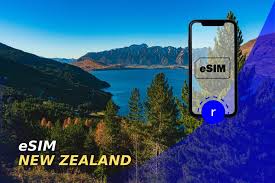What’s Best for Your New Zealand Vacation

Planning a trip to New Zealand? You’re in for an incredible adventure filled with stunning landscapes, from the rolling hills of Hobbiton to the dramatic peaks of Milford Sound. But before you pack your bags, there’s one crucial detail you need to sort out: staying connected during your journey.
Many travelers face the same frustrating problems when it comes to mobile connectivity abroad. Surprise roaming charges that can cost hundreds of dollars. Patchy network coverage that leaves you stranded without GPS in remote areas. The hassle of hunting down local SIM cards in unfamiliar airports or stores. These connectivity headaches can quickly turn your dream vacation into a stressful experience.
This article will help you choose between two main options for staying connected in New Zealand: modern eSIM technology and traditional physical SIM cards. By the end, you’ll know exactly which solution fits your travel style, budget, and tech comfort level.
Why Connectivity Matters for Your New Zealand Trip
Before diving into the technical details, let’s talk about why reliable mobile connectivity is essential for your New Zealand adventure.
The Challenges of Staying Connected Abroad
International travel comes with unique connectivity challenges that can catch even experienced travelers off guard. Roaming charges are perhaps the biggest concern. Many travelers return home to phone bills exceeding $500 or more after a two-week trip, simply because they didn’t realize their regular plan’s international rates.
Network coverage becomes especially tricky in New Zealand’s diverse landscape. While cities like Auckland and Wellington offer excellent coverage, remote areas like Fiordland National Park or the Southern Alps can have spotty signals or complete dead zones. This inconsistency can be dangerous if you’re hiking alone or driving through unfamiliar territory.
Language barriers and unfamiliar processes add another layer of complexity. Finding the right store, understanding local prepaid plans, and navigating foreign telecom websites can waste precious vacation time. Many travelers end up paying more than necessary because they couldn’t research alternatives or compare prices effectively.
What Travelers Need from a Connectivity Solution
Modern travelers need connectivity solutions that address real-world problems without creating new ones. Affordability tops the list – you want predictable costs without surprise charges that blow your travel budget.
Ease of setup matters just as much. After a long flight to Auckland, the last thing you want is to spend hours searching for a phone store or struggling with complicated activation processes. You need something that works immediately so you can navigate to your hotel, book activities, and start exploring.
Reliable coverage across New Zealand’s varied terrain is crucial. Whether you’re photographing glaciers on the South Island or exploring geothermal wonders in Rotorua, your connection should work consistently. Finally, flexibility allows you to adjust your plan if you decide to extend your stay or need more data for sharing those incredible Instagram moments.
Understanding eSIMs: A Modern Travel Solution
Technology has revolutionized how we stay connected while traveling, and eSIMs represent the latest evolution in mobile connectivity.
What Is an eSIM and How Does It Work?
An eSIM (embedded SIM) is a digital version of the traditional plastic SIM card that’s built directly into your phone. Instead of inserting a physical card, you download a digital profile that connects your device to local networks. Think of it as getting a virtual key to unlock local cellular networks without needing any physical hardware.
The process is surprisingly simple. You purchase an eSIM plan online, receive a QR code via email, and scan it with your phone’s camera. Within minutes, your device connects to local New Zealand networks as if you had a local SIM card. Most newer smartphones, including recent iPhones and Samsung Galaxy models, support eSIM technology.
Benefits of eSIMs for Travelers in New Zealand
The convenience factor alone makes eSIMs attractive for New Zealand travelers. You can purchase and activate your plan before leaving home, ensuring connectivity the moment you land in Auckland or Christchurch. No more searching for telecom stores or dealing with language barriers.
Flexibility becomes a huge advantage during your trip. If you’re exploring both islands and need more data, you can easily top up your plan online. Planning to visit Australia after New Zealand? You can switch to an Australian eSIM plan without changing physical cards or losing your original SIM.
For tech-savvy travelers, eSIMs offer sophisticated features like maintaining multiple plans simultaneously. You could keep your home number active for emergencies while using the best esim for new zealand for local connectivity. This dual-SIM functionality proves invaluable for business travelers or those who need to stay accessible on their home number.
Potential Drawbacks of eSIMs
Despite their advantages, eSIMs aren’t perfect for every traveler. Device compatibility represents the biggest limitation. Older smartphones, budget devices, and some international phone models don’t support eSIM technology. Always check your device specifications before planning to rely on an eSIM.
The initial setup requires basic technical comfort and internet access. While the process is straightforward, travelers who struggle with technology might find scanning QR codes and navigating digital menus challenging. Additionally, if something goes wrong with your eSIM activation, troubleshooting requires internet access, which creates a chicken-and-egg problem.
Traditional SIM Cards: The Classic Choice
Physical SIM cards remain the tried-and-true method for international connectivity, offering familiarity and universal compatibility.
How Traditional SIM Cards Work for Travelers
Traditional SIM cards require you to purchase a physical card and insert it into your unlocked phone. In New Zealand, you’ll find these cards at airports, convenience stores, and telecom shops throughout major cities. The process involves removing your home SIM card, inserting the New Zealand SIM, and following activation instructions.
Most New Zealand networks like Spark, Vodafone, and 2degrees offer tourist-friendly prepaid plans with various data allowances. These plans typically include local calling and texting, plus internet data for navigation and social media. The physical nature of these cards means they work with virtually any unlocked phone, regardless of age or model.
Advantages of Traditional SIM Cards
Universal compatibility stands as the traditional SIM card’s greatest strength. Whether you’re carrying a five-year-old iPhone or a basic Android device, physical SIMs work with virtually any unlocked phone. This reliability makes them ideal for travelers with older devices or those who prefer not to depend on newer technology.
Availability provides another significant advantage. New Zealand’s airports, particularly Auckland and Christchurch, have multiple telecom kiosks where you can purchase SIM cards immediately after landing. Convenience stores, electronics shops, and dedicated phone stores throughout the country stock prepaid SIMs, making it easy to buy additional data or replace lost cards.
The familiar process appeals to travelers who prefer traditional methods. Many people feel more comfortable with physical cards they can see and touch, rather than digital profiles they must trust to work correctly. This tangible aspect provides peace of mind for less tech-savvy travelers.
Challenges of Using Traditional SIM Cards
Time consumption represents the most significant drawback of traditional SIM cards. After a long international flight, you’ll need to locate a store, wait in line, compare plans, and complete the purchase process. This delay can add 30-60 minutes to your arrival routine when you’re eager to start exploring.
The risk of losing your home SIM card during the swap process causes anxiety for many travelers. These tiny cards are easy to misplace, and losing your original SIM means losing your home phone number until you can get a replacement. Some travelers solve this by bringing a separate phone, but this adds weight and complexity to their packing.
Limited flexibility becomes apparent when you need to change plans or add data. Unlike digital solutions, physical SIMs require visiting stores or finding top-up locations. If you’re hiking in remote areas or exploring small towns, finding these services can be challenging or impossible.
eSIM vs. Traditional SIM: A Side-by-Side Comparison
Understanding how these two options stack up against each other helps you make the best choice for your New Zealand adventure.
Cost and Affordability
Pricing for both options varies significantly based on data allowances, coverage areas, and plan duration. Traditional SIM cards in New Zealand typically range from $20-60 NZD for tourist plans, depending on data limits and validity periods. Airport kiosks often charge premium prices, while convenience stores may offer more competitive rates.
eSIM plans often match or beat traditional SIM pricing, with the added benefit of transparent, upfront costs. When you purchase an eSIM online, you see exactly what you’re paying without hidden activation fees or surprise charges. Many eSIM providers offer specialized tourist plans designed specifically for short-term visitors, providing better value than generic prepaid options.
The hidden costs of traditional SIMs include transportation to purchase locations, time spent researching and comparing plans, and potential overage charges if you exceed your data limit. These factors can make traditional SIMs more expensive than their advertised prices suggest.
Ease of Use and Setup
Setup complexity differs dramatically between these options. eSIM activation takes minutes once you understand the process. Purchase online, receive a QR code, scan it with your phone’s camera, and you’re connected. This process can be completed from anywhere with WiFi, including your hotel room or the airport lounge.
Traditional SIM setup requires physical presence at purchase locations, plus the time to research options and complete transactions. The actual installation process is simple – just swap cards – but the entire process from research to activation can take hours. Consider arriving in Auckland at 9 PM when most stores are closed, forcing you to wait until morning for connectivity.
For travelers continuing to other destinations, eSIMs offer unmatched convenience. Planning to explore Europe after New Zealand? You can easily switch to an europe esim plan without visiting stores or managing multiple physical cards.
Coverage and Reliability
Network coverage depends more on the underlying infrastructure than the type of SIM you choose. Both eSIMs and traditional SIMs connect to the same New Zealand networks: Spark, Vodafone, and 2degrees. However, your choice of provider and plan affects which networks you can access.
Some eSIM providers offer multi-network access, automatically connecting you to the strongest available signal. This feature proves particularly valuable in New Zealand’s diverse landscape, where network coverage varies significantly between providers and regions. Traditional SIMs typically lock you to one network, limiting your options in areas with poor coverage.
Coverage maps from official sources like the New Zealand Commerce Commission show that all major networks provide excellent coverage in cities and tourist areas. However, remote locations like Stewart Island or parts of the West Coast may have limited coverage regardless of your connectivity solution.
Flexibility for Travelers
eSIMs excel in providing flexibility throughout your journey. Need more data for uploading photos from Milford Sound? Top up online instantly. Extending your stay? Purchase additional validity periods without visiting stores. This flexibility proves invaluable for travelers whose plans change frequently.
Traditional SIMs offer limited flexibility, often requiring store visits for plan changes or additional credit. Some networks allow online top-ups, but these services may be difficult to navigate for foreign visitors. The physical nature of traditional SIMs also means you can’t easily switch between multiple plans or maintain backup connections.
For travelers exploring multiple countries, eSIMs provide seamless transitions. After your New Zealand adventure, you could activate an esim for uk travel for your next destination without managing multiple physical cards or worrying about losing your home SIM.
Why Simify Is the Go-To Choice for Seamless New Zealand Connectivity
Among the various eSIM providers available, Simify stands out as a trusted solution specifically designed for travelers facing real connectivity challenges. Understanding that modern travelers need reliable, affordable, and hassle-free connectivity, Simify has developed eSIM plans that address the common pain points we’ve discussed throughout this article.
Simify’s approach focuses on simplicity and value. Their New Zealand eSIM plans offer competitive pricing without hidden fees, transparent data allowances, and instant activation that works the moment you land. Unlike traditional SIM cards that require time-consuming store visits, Simify’s digital-first approach means you can purchase, activate, and start using your connection within minutes of arrival.
The company’s commitment to traveler-centric solutions shows in their coverage optimization. Simify’s New Zealand plans are designed to work seamlessly across the country’s diverse terrain, from urban centers to remote tourist destinations. Their customer support team understands traveler needs and provides assistance in multiple languages, eliminating the communication barriers that often complicate traditional SIM purchases.
Which Option Is Best for Your New Zealand Vacation?
Choosing between eSIMs and traditional SIMs depends on your specific travel style, technical comfort level, and device compatibility.
Best for Digital Nomads and Remote Workers
Digital nomads and remote workers benefit most from eSIM solutions, particularly for New Zealand’s growing remote work scene. With cities like Wellington and Auckland offering excellent coworking spaces and cafes, eSIMs provide the flexibility and high-data allowances needed for video calls, file uploads, and constant connectivity.
The ability to maintain multiple connections simultaneously proves invaluable for remote workers. You can keep your home number active for client calls while using local New Zealand connectivity for internet access. This dual-SIM functionality eliminates the need for multiple devices or complex forwarding arrangements.
Best for Adventure Travelers
Adventure travelers exploring New Zealand’s incredible outdoor activities need reliable connectivity for safety and navigation. Whether you’re hiking the Milford Track, skiing in Queenstown, or exploring geothermal areas around Rotorua, eSIMs offer better coverage options through multi-network access.
The instant activation capability proves crucial for adventure travelers whose plans change frequently. If you decide to extend your South Island exploration or switch from hiking to skiing, you can adjust your connectivity plan immediately without searching for stores in remote locations.
Best for Short-Term Tourists
Short-term tourists (1-2 weeks) can benefit from either option, but eSIMs offer superior convenience for quick trips. The time savings from instant activation versus store visits becomes more significant when you have limited vacation days.
However, tourists with older devices or those uncomfortable with technology should consider traditional SIMs. The familiar process and widespread availability make traditional SIMs a safer choice for travelers who prefer proven solutions over new technology.
Best for Budget Travelers
Budget-conscious travelers will find competitive options in both categories, but eSIMs often provide better value through transparent pricing and flexible top-up options. The ability to purchase exactly the data you need, without paying for unused allowances, can result in significant savings.
Budget travelers should also consider the hidden costs of traditional SIMs, including transportation to purchase locations and potential overage charges. These factors can make seemingly cheaper traditional SIMs more expensive than comparable eSIM plans.
Tips for Choosing and Using Your Connectivity Solution
Making the right choice requires considering several practical factors beyond just cost and convenience.
Check your device compatibility before committing to either option. For eSIMs, verify that your phone model supports the technology and that it’s unlocked for international use. Most carriers can unlock phones for international travel, but this process takes time and may incur fees.
Research New Zealand’s network coverage for your specific destinations. While all major networks provide excellent coverage in cities and tourist areas, remote locations may favor certain providers. The New Zealand government’s official tourism website offers updated coverage information for popular destinations.
Consider purchasing your connectivity solution before departure. eSIMs can be bought and configured at home, ensuring everything works before you travel. Traditional SIM cards can sometimes be purchased online and delivered to your hotel, though this option is less common.
Keep backup connectivity options in mind. New Zealand offers excellent public WiFi in most tourist areas, libraries, and accommodations. Understanding where you can access free internet helps you plan data usage and provides alternatives if your primary connection fails.
Conclusion
The choice between eSIMs and traditional SIM cards for your New Zealand vacation ultimately depends on your personal preferences, device compatibility, and travel style. Both options can provide reliable connectivity, but they serve different types of travelers.
eSIMs offer unmatched convenience, flexibility, and modern features that appeal to tech-savvy travelers and those who value efficiency. The instant activation, transparent pricing, and multi-network capabilities make them ideal for most modern travelers. Providers like Simify have specifically designed their services to address traveler pain points, offering seamless connectivity solutions that work from the moment you land.
Traditional SIM cards remain valuable for travelers with older devices, those who prefer familiar processes, or anyone who enjoys the tangible nature of physical cards. They’re widely available and universally compatible, making them a reliable fallback option.
Consider your device compatibility, technical comfort level, and travel plans when making your decision. For most travelers visiting New Zealand, eSIMs provide the best combination of convenience, value, and reliability. The ability to activate instantly, adjust plans on the fly, and maintain multiple connections makes them the superior choice for modern travel.
Whatever option you choose, the key is planning ahead and understanding your connectivity needs. New Zealand’s incredible landscapes and adventures await – make sure you stay connected to capture and share every moment of your journey.
FAQs
1. Can I use an eSIM with any smartphone in New Zealand?
eSIMs require compatible devices, typically newer smartphones released after 2018. Recent iPhones (XS and later), Samsung Galaxy models (S20 and newer), and Google Pixel phones (3 and later) support eSIM technology. Check your device settings under “Cellular” or “Mobile Data” to see if “Add Cellular Plan” appears – this indicates eSIM compatibility. Always verify compatibility before purchasing an eSIM plan.
2. Are eSIMs more expensive than traditional SIM cards in New Zealand?
Costs vary by provider and plan, but eSIMs often match or beat traditional SIM pricing. Traditional SIMs typically cost $20-60 NZD for tourist plans, while eSIMs offer similar pricing with transparent, upfront costs. eSIMs eliminate hidden fees like activation charges and provide better value through flexible top-up options. Providers like Simify offer competitive plans specifically designed for travelers, often providing better value than generic prepaid options.
3. How do I activate an eSIM for my New Zealand trip?
Activating an eSIM is straightforward: purchase a plan from a provider like Simify, receive a QR code via email, and scan it with your phone’s camera in the cellular settings. The process takes minutes and can be completed anywhere with WiFi. Your device will download the digital profile and connect to New Zealand networks automatically. Most providers include step-by-step instructions, and customer support can assist if needed.
4. Will an eSIM work in New Zealand’s remote areas like Fiordland?
eSIMs connect to the same networks as traditional SIMs, so coverage depends on the underlying infrastructure rather than the SIM type. New Zealand’s major networks (Spark, Vodafone, 2degrees) provide good coverage in tourist areas, but remote locations like Fiordland may have limited connectivity regardless of your SIM choice. Some eSIM providers offer multi-network access, automatically connecting to the strongest available signal, which can improve coverage in marginal areas.
5. What happens if I run out of data on my eSIM or SIM card in New Zealand?
eSIMs offer convenient online top-ups through your provider’s website or app. Companies like Simify allow instant data purchases and plan extensions without visiting stores. Traditional SIMs require physical top-ups at stores, online through the carrier’s website, or by purchasing top-up vouchers at convenience stores. eSIMs provide more flexibility, especially in remote areas where physical stores may be unavailable. Always monitor your data usage and top up before completely running out to avoid service interruptions.




